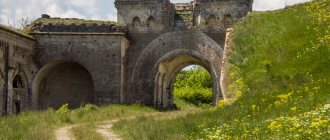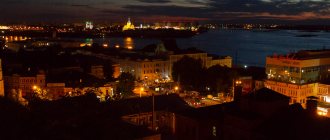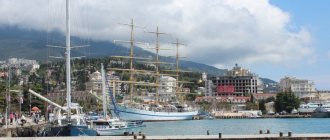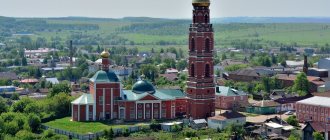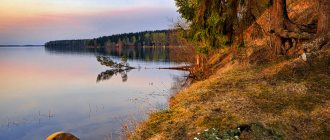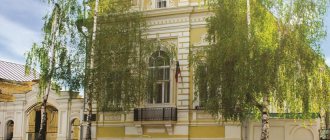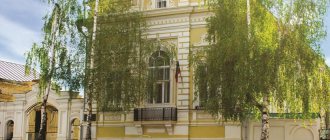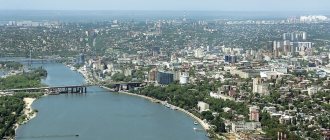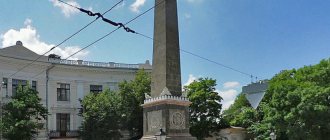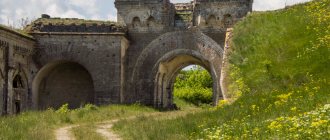The road took me to Vitebsk, when I and my grandfather were traveling to the village of Gorodyansky Mokh, where my great-grandfather rests in a huge mass grave, among 2,500 Soviet soldiers. I won’t bore you with the details of that trip, but will tell you what I managed to see in Vitebsk in a day on my own, what sights are worth visiting and whether there are sightseeing tours around the city.
- The main attractions of Vitebsk: what to see in one day
- Temples in Vitebsk
- Other sights of Vitebsk
- Was it worth going to Vitebsk? My review
- Sights of Vitebsk on the map
Vitebsk: what a tourist can see in 1 day
Thanks to some attractions, Vitebsk has become known far beyond the country's borders. It is these that tourists try to explore not in 2, but in 1 day.
House of Marc Chagall
- Address: Pokrovskaya, 11a.
Marc Chagall can easily be called the most famous native of Vitebsk. The future artist's parents were poor, but owned several houses. Of the four buildings, only one brick house has survived to this day, where little Mark’s family lived.
Inside, the furnishings of a typical Jewish house of the late 19th and early 20th centuries are recreated. The reenactors were guided by Chagall’s own illustrations, which he created for his autobiography “My Life.” The building has five rooms: a living room, a red room, a room for Mark and his brother, a kitchen and a grocery store where the mother of the family traded. The museum contains authentic items and unique photographs of the artist.
The opening of the museum attraction took place in 1997 - in honor of the 110th anniversary of the birth of Mark Zakharovich. The Chagall House forms a single complex with an art center where exhibitions of the artist’s works are held.
Summer amphitheater
- Address: ave. Frunze, 13a.
A modern large-scale building is located in the historical center of the city. The first stage was erected here in 1988. Thanks to technological progress, today the amphitheater has the latest equipment. The hall is designed for 6000 people. The famous Vitebsk Bazaar festival is held annually on the stage of the amphitheater.
Estate "Zdravnevo"
- Coordinates on the map: 55.319918, 30.337320.
16 km from Vitebsk is the estate of I.E. Repina. The artist purchased the plot in 1892 with the money received from the painting “Cossacks writing a letter to the Turkish Sultan.” In the summer, the picturesque corner inspired the artist to paint new canvases.
All the manor buildings were wooden and have not survived to this day. In 1988, the estate began to be restored according to the drawings of the owner himself.
Exact copies of the manor's house and the manager's house were placed on the territory. Each building housed a separate exhibition. Among the exhibits are personal belongings of Repin and his relatives, rare photographs, letters and the master’s work supplies.
Square of victory
- Address: pl. Victory.
The largest square in Vitebsk is located on the banks of the Western Dvina. A significant part of it is occupied by a memorial called “Three Bayonets”. In the middle of the complex there is a huge monument in the form of three bayonets connected by a bas-relief. Each bayonet symbolizes the military force that fought against the German invaders:
- army and soldiers
- partisan movement,
- underground resistance.
In front of the monument, at a short distance, there is a sculptural composition of several bronze figures of soldiers carrying the Red Banner. To the side of the memorial, events are held and fountains operate. For the New Year they put up a huge Christmas tree here. The grand opening of the square took place in 1974, a significant year for Vitebsk, when the city celebrated its thousandth anniversary and the 30th anniversary of its liberation from German invaders.
Blagoveshchensky cathedral
- Address: Zamkovaya, 1.
The most ancient temple in Vitebsk, a monument of Polotsk stone architecture, was erected in the distant 12th century. Time and people have treated the magnificent cathedral complex cruelly. The church repeatedly suffered from enemy raids, but each time it was reborn like a phoenix from the ashes.
The destruction during the Great Patriotic War was so serious that at the Nuremberg trials Germany was required to compensate for the damage caused, as well as damage from other Nazi crimes. However, the final, fatal blow to the temple was dealt not by foreign invaders, but by compatriots. During the reign of N.S. Khrushchev's building was blown up to lay tram tracks in its place.
In the 90s, architect G.A. Lavretsky reconstructed the cathedral. The preserved ancient foundation and part of the wall became the basis for the new structure. The ancient masonry was not plastered and painted like the rest of the building. The unusual solution gave the cathedral a special “zest” and attractiveness for tourists.
Berezinsky Biosphere Reserve
What to do if a small family member is traveling with you? Of course, it’s easier to find where to go with a child in Minsk. However, Vitebsk also has something to offer for a family holiday. The Berezinsky Biosphere Reserve is suitable for regular hunting tourism and for walks with children. Guests of the reserve have a choice of visiting options: if you want, buy a 1-day excursion to the natural museum, or if you want, book a multi-day ecological tour. Right here there is a hotel complex and houses for receiving guests.
Berezinsky Biosphere Reserve
Thousands of years ago there were vast bodies of water and dense forests, in which many different animals were found. The reserve itself was created on the initiative of the leadership of the BSSR in 1925, since this area turned out to be an ideal habitat for beavers. A little earlier it was believed that the European beaver had been completely exterminated, but in 1924 this endangered species of mammal was discovered by a special expedition. The locals joke: “It’s all the beavers’ fault.” In other words, if they had not been found, there would have been no reserve.
- Where is it located: on the border of Vitebsk and Minsk regions.
- Opening hours: daily from 8:00 to 17:00.
- Cost: entrance ticket to the Museum of Nature - 3 and 2 BYN for adults and children. The same price applies to demonstration enclosures. Single ticket - 5 and 3 BYN. Excursion services are paid separately.
Green lungs of Vitebsk: parks and gardens
Vitebsk can be called a city of parks. Equipped park areas and lush gardens are wonderful places for a healthy rest.
Botanical Garden
- GPS coordinates: 55.200385, 30.212454.
The picturesque garden on the banks of Vitba is a kind of teaching aid for students of Vitebsk University and a place for walks for ordinary citizens and tourists.
The basis of the botanical garden is a small plot laid out in the distant 18th century. In 1919, thanks to the efforts of an agronomist with the telling surname Sadovsky, a research center for the study of botany appeared on the site. Six acres of land eventually grew to four hectares, on which thousands of plants were planted.
The territory of the Botanical Garden is open to everyone. There is a greenhouse in the garden where you can admire exotic plants and purchase seedlings.
Winners Park
- Address: Kalinina, 5.
Victory Park is located a few meters from the square of the same name. Former park named after. Kalinin received a new name in 2010 - in honor of the 65th anniversary of the Great Victory. At the same time, an exhibition of military equipment from the Great Patriotic War appeared in the park, which became the most interesting attraction of Vitebsk.
Pobediteley Park is a popular place for family walks. The paths here are lined with red tiles, and there are benches for rest everywhere. The park has rides, a parachute tower, fountains and a cafe. The area has been made accessible to disabled people and the elderly: ramps and railings are equipped on the slopes next to the steps.
Park named after Frunze
- Address: Lenina, 35a.
The former bishop's garden became accessible to ordinary citizens only during Soviet times. In 1926, the new park received the name of the famous Russian revolutionary. On the territory there are paths, stone stairs and a fountain, and attractions. The park offers a beautiful view of the Vitba River. In the summer, you can rent a boat or catamaran for a boat trip and go on an excursion.
Park "Mazurino"
- Address: Mazurinskaya street.
Another name for the park on the banks of the Western Dvina is “Soviet Army Park”. The green zone near the village of Mazurino began to be developed soon after the end of the war, and a year after the Victory the territory was opened to visitors.
The park has created conditions for active recreation: jogging paths have been laid, and in winter there is space for ski slopes. Folk festivals and festive concerts are held on the open-air summer stage.
Old city
One of the oldest attractions in Vitebsk dates back to the 17th and 18th centuries. Residential buildings and all kinds of civil institutions remind us of what buildings looked like in those distant times. Although only fragments of the street buildings have been preserved.
Old city
What is included in the architectural zone: Land Bank, Town Hall Square ensemble. Also in this area (along Chekhova Street) you can look at the original Vitebsk houses with a predominant burgundy color. Such an original color of ancient Vitebsk architecture is explained by the special composition of the clay.
- Where it is located : approximately within the boundaries of Tolstoy, Lenin, Suvorov, Krylov and Yanka Kupala streets.
Vitebsk museums and theaters
Vitebsk is famous not only for its ancient history, but also for its rich cultural heritage. You can get acquainted with the past and present of the city in local museums, and relax your soul in the theaters.
Museum of Local Lore
- Address: Lenina, 36.
The oldest museum of Vitebsk and all of Belarus was placed in the city hall building. The meeting began in 1868 on the initiative of the Provincial Statistical Committee. The founder of the first museum is collector A.R. Brodovsky, who was subsequently appointed its head.
The main collection, consisting of tens of thousands of items, was preserved even during the most difficult periods of history for the country. During the Great Patriotic War, the museum was evacuated to the rear; after the liberation of Vitebsk, the exhibitions returned to their homeland.
Almost all modern museums in Vitebsk are branches of the Museum of Local Lore. Today, the collections of the complex attraction include more than 200 thousand exhibits, including ancient coins, paintings, tapestries, Christian relics, porcelain and much more.
Art Museum
- Address: Lenina, 32.
Fine arts exhibitions are held in the classical building from the late 19th century. Previously, the district court operated in the architectural monument. The museum's collections contain more than 10 thousand works of art. A significant part of the exhibits consists of works by Belarusian painters and graphic artists, antique dishes, lace and handmade embroidered items. Among the paintings you can find canvases by such world-famous artists as Levitan, Kuindzhi, Repin, Shishkin and Perov.
Dukhovsky roundabout
- Address: Frunze Avenue, 13a/1.
The exhibition center of the city of Vitebsk received its unusual name in honor of the tower at the Olgerd Castle. A high quadrangular tower was built over the foundations of a medieval palace. Fragments of ancient masonry can be seen on the lower level of the center in the basement of the building.
The second level of the center coincides with the first floor of the tower and is dedicated to the history of Vitebsk. The main exhibit is a three-dimensional model showing the city in 1664. The third and fourth levels tell about the famous “Vitebsk Bazaar”. There is an observation deck located right under the roof.
Tram History Museum
- Address: 5th Frunze Street, 7.
At the beginning of the 20th century, Vitebsk was ahead of many settlements in the Russian Empire, and then the USSR, in technical development. It was here in 1898 that the first electric tram for Belarus appeared. Vitebsk became the third city in the entire Empire where an electric tramway began operating.
In 1966, the Vitebsk Tram Museum opened. Now it houses an impressive collection of materials related to the history of electric transport in the city. The exhibits are divided into five sections dedicated to the main milestones in the development of the tram. The museum houses a tram depot full of examples from different periods of history. Some copies have been preserved in working condition.
Theater named after Yakub Kolas
- Address: Zamkovaya, 2.
The Drama Theater began its existence in 1926. During the Great Patriotic War, the troupe was evacuated to the rear, where the actors continued to stage performances. In 1944, the theater received the name of the writer Yakub Kolas, and was later awarded the Stalin Prize. For its high level of professionalism, the drama theater was awarded the title of academic. A classical building decorated with columns was built especially for the theater.
Theater "Lyalka"
- Address: Pushkina, 2.
The Lyalka puppet theater was created in 1985 thanks to the enthusiasm of the actors of the Drama Theater. Within five years, the troupe acquired its own home and an enviable repertoire. The building has a hall for 130 people and a small doll museum. All 30 performances were staged in Belarusian. The theater successfully tours neighboring cities and countries and has won several international awards.
Summer amphitheater
If you have planned a trip to the most interesting places in Belarus and want to bring back not only souvenirs from Minsk and Vitebsk, but also pleasant memories, also visit the summer amphitheater. This is a concert venue designed for an audience of more than 6 thousand, the main stage of the famous “Slavic Bazaar”.
Summer amphitheater
There was once no roof here, but weather conditions are unpredictable and it sometimes rained during events. In this regard, the roof was finally erected in 2007. Inside the complex there is a cafe "Maestro". The Avenue of Stars is located nearby. You can admire the building from the outside at any time, but the door to the middle is open only during events.
- Address: Frunze Avenue, 13 A.
Architecture of Vitebsk: where to go to take a photo
Time, natural disasters and military operations have not spared the architectural appearance of this city of Belarus. Some architectural monuments were saved from extinction or restored from scratch.
Town Hall
- Address: Lenina, 36.
The first town hall appeared in Vitebsk at the end of the 16th century, when the city was granted Magdeburg Law. Over the next two centuries, the wooden structure was repeatedly burned and rebuilt until a stone structure took its place.
At one time, the building was occupied by the fire service, which is why the town hall received the popular nickname “Calancha”. After numerous reconstructions, the architectural monument lost its original appearance. Today the town hall is a three-story building with a multi-tiered quadrangular tower. On one of the upper tiers there is a clock, above which there is an observation deck.
Since 1924, the Vitebsk Local History Museum has been operating in the town hall. At night, the building is illuminated by numerous floodlights.
Governor's Palace
- Address: Sovetskaya, 18.
Since the 18th century, the rulers of the Vitebsk province lived in a beautiful two-story mansion and other high-born persons periodically stayed. In 1812, Napoleon Bonaparte came to the residence. It was from here that the King of France moved towards Smolensk during the Patriotic War.
At various times, representatives of the Russian imperial family visited the palace: Grand Duke Constantine, son of Paul I, and the future Emperor Alexander II. The famous writer Ivan Lazhechnikov wrote several works at the residence when he was vice-governor.
The building was built in a classical style and decorated with columns. During the Great Patriotic War, only the walls remained of the palace, but a few years later the building was restored. At the moment, the palace serves as the headquarters of the KGB; entry into the premises is strictly prohibited, but this makes its appearance appear in photographs no less often.
Salt warehouses
- Address: Tchaikovsky, 5.
Spacious food storage facilities were built in 1774. Warehouses, or storehouses in other words, were intended for stocks of essential products in case of war. Of the three buildings connected by arches, two have survived.
The storehouse acquired particular relevance during the Second World War. Today it operates in the salt warehouse building. In addition to exhibitions, educational master classes are held at the folk crafts center.
Entertainment centers
At the Ocean family recreation center, both children and adults will find something to their liking. Every day from 10:00 to 20:00 you will find game attractions and labyrinths: a children's play area with spinning carousels, a labyrinth area with intricate climbs, 2 trampolines, pools with balls, slides, pneumatic guns, etc. Cheerful animators will help organize a children's party.
Entertainment centers
Family recreation center "Ocean"
Vitebsk, Pobedy Ave., 15 (MEGA shopping center) 55.169208 30.224765
+375
Mon.-Fri.: from 10:00 to 20:00
vk.com/vitebsk_ocean
Read more
The main feature of children's entertainment is the railway. All the kids come running when the bell rings.
There are exciting games for different ages, a party room, and various animation programs.
Entertainment centers
Children's entertainment
Vitebsk, st. Generala Beloborodova, 3 55.168174 30.269397
+375 (33) 399-99-03
Mon-Sun: from 10:00 to 20:00
vk.com/vitebsk_boom
Read more
The entertainment center also has a lot of regulars. In our REVIEW you will find out all the details.
Entertainment centers
Amusement park "The Jungle is Calling"
Vitebsk, Moskovsky Ave., 86 55.176300 30.247877
+375
Tue. – Sun: from 10:00 to 21:00
Mon: closed
Read more
Even more entertainment centers and playrooms for children in Vitebsk HERE.
Holy churches and monasteries of Vitebsk
Almost all religious buildings in Vitebsk are Catholic and Orthodox. Many churches of the Russian Orthodox Church previously belonged to either Catholics or Uniates, and therefore are very different from the usual buildings in Orthodoxy.
Holy Spirit Monastery
- Address: Tolstoy, 13.
One of the oldest Orthodox monasteries in Belarus was founded in the 14th century. The storm of history repeatedly raged at the monastery walls, disrupting the regular flow of monastic life.
The sisters were persecuted, the monastery was given to the Uniates, and again returned to the Orthodox. After the Revolution, the Temple of the Holy Spirit fell under a wave of destruction that swept across the territory of the former Empire.
The revival of the monastery began after the collapse of the Soviet Union. The three-story cell building and the Church of the Holy Spirit were rebuilt. The consecration of the new church took place in 2012.
Assumption Cathedral
- Address: Commissioner Krylov, 9.
The background to the appearance of the cathedral is full of incredible events. According to legend, in pagan times the hill on the bank of the Western Dvina, on which the temple now stands, served as a temple. In the Middle Ages, local residents converted to Christianity and built an Orthodox church on a hill. Later, the rulers accepted the Union, but the townspeople rebelled against such a change and destroyed the temple.
In the 18th century, a Basilian monastery grew on the hill. Years later, the community was abolished, and the main church of the monastery was transferred to the Orthodox Church. In 1936, the long-suffering cathedral was blown up.
After the collapse of the USSR, the Church of the Assumption of the Blessed Virgin Mary was rebuilt on the hill. Patriarch Alexy II was present at the laying of the foundation. The new cathedral was built according to the model of its predecessor. The white-walled structure is shaped like a cross and topped with a large gilded dome. Bell towers are located symmetrically on both sides of the entrance. Before services, the area is heard by the ringing of the largest bell in Belarus.
Church of St. Barbarians
- Address: Leningradskaya, 27.
One of the few ancient churches remaining under the jurisdiction of the Roman Catholic Church. The classic Catholic church was built with donations from Anthony Kosov in 1785. The magnificent building is built of red brick in the neo-Romanesque style.
The walls and bell towers are decorated with elegant figured masonry. Initially, the church stood next to the cemetery. Soviet power, and after the war, practically destroyed the architectural monument. At the end of Perestroika, the building was returned to believers and reconstructed.
Church of the Merciful Jesus
- Address: Voinov-Internationalistov, 28.
The main Catholic church of the city was built in 2009. The Cathedral is the youngest and most spacious of the Vitebsk churches. The huge building accommodates about 1,500 believers. Adjacent to the church is the two-story building of the Catholic Center. In front of the church there is a monument to John Paul II. The bronze sculpture of the Pope is a gift from Polish Catholics.
Intercession Cathedral
- Address: Shubina, 2.
The cathedral with a complicated history was built in 1814. Initially, the church was the center of a Catholic monastery, but 33 years later the community ceased to exist and the building was given to the Orthodox Church. Ironically, the former Catholic church became one of the main Orthodox cathedrals in the city.
When the Bolsheviks came to power, services in the temple stopped. During the war, the building was damaged by shelling, but was able to survive. In the 80s, reconstruction began, and in 1990, the first divine service was held within the walls of the cathedral. Today the facade of the monastery is decorated with frescoes, and the territory is surrounded by a stone fence.
Resurrection Church
- Address: Suvorova, 2a.
The Church of the Resurrection, built in 1772, largely repeated the fate of the Assumption Cathedral. The building originally belonged to the Uniate Church, but in the mid-19th century it came under the jurisdiction of the Orthodox.
In 1936, the city underwent a massive demolition of religious buildings, which included the Resurrection Church. The new building was built in 2009. Like the original, the building is made in the Vilna Baroque style. The walls of the temple were painted by Vitebsk masters.
Let's sum it up
As you can see, Vitebsk really is one of the most interesting historical Belarusian places. The city lives with the memories of two outstanding artists, and tourists try to learn more about their lives and activities. The largest event in Vitebsk is the Slavic Bazaar. In addition, this Belarusian regional center has a cozy feel, and the surrounding area reminds of the wealth of natural resources, including flora and fauna.
If you are exploring Belarusian sights and have a lot of time, you can stop by the capital. Of course, in Minsk you can mainly look at the modern benefits of civilization. But this is also necessary.
The most interesting monuments in Vitebsk
The streets of Vitebsk abound with sculptures made of bronze and stone. By exploring local monuments and taking a walk around the city, you can learn about unusual people and important historical figures.
Monuments to Marc Chagall
- Address: Pokrovskaya street.
There are two monuments to Marc Chagall in Vitebsk. The first monument was erected in 1992. The artist is depicted sitting thoughtfully in a chair with a palette in his hand. Hovering above the master is the love and muse of his life - his first wife Bella.
- Address: Putna street.
The second monument stands in the courtyard of the Chagalovs' house. The sculpture “Chagall’s Violin” was created in the master’s unique style: a young man sits on a foal and plays, like a violin, on a miniature Eiffel Tower, at the foot of which stands tiny Vitebsk. Instead of a bow, the artist uses a brush.
Monument to Olgerd
- Address: Tolstoy, 2.
The bronze figure of Prince Olgerd is located in the center of Vitebsk. The gallant man on a noble trotter extended forward his right hand, on which the falcon sits. The pedestal under the sculpture is decorated with bas-reliefs.
The talented Lithuanian ruler played an important role in the development of Vitebsk. It was Olgerd who turned a small territory into a large principality that had influence on neighboring Smolensk, Pskov and Veliky Novgorod. Under the prince, Vitebsk was transformed from a modest settlement into a city; stone castles surrounded by fortress walls grew in place of wooden buildings.
Olgerd led a wise foreign and domestic policy, thanks to which he won more than one victory over foreigners and was able to avoid popular riots.
Monument to Alexander Nevsky
- Address: Millennium Square in Vitebsk.
The sculpture of the blessed prince stands not far from the Annunciation Cathedral. The bronze monument differs from most monuments to the ruler, as it depicts him not as a warrior or monk, but as a family man. The commander is dressed in princely clothes, a child is sitting in his arms, and his wife is standing next to him.
street clown
- Address: Frunze Ave., 11.
An interesting sculptural composition entertains passers-by with its funny appearance. A fat clown with a good-natured face plays a large accordion, a faithful poodle sits next to him and an open wallet with coins lies. The composition is also called “Wandering Musician”. The clown and his pet are a gift to the city from artist Nikolai Chelnokov. The author of wonderful sculptures is Vitebsk master Ivan Kazak.
Vitebsk giant
- Address: Mayakovsky street.
The Belarusian giant, or Gulliver, was called Fyodor Makhnov, a native of the village of Kostyuki, a man of outstanding appearance and destiny. The amazing man was the tallest man in the world, his height was 285 cm.
During his short life, Makhnov managed to work in a German circus, earn a fortune, travel throughout Europe and even meet the Pope. The giant was also successful in family life - he had a wife and children.
The further fate of the Makhnovs was tragic. The head of the family died in 1912 at the age of 34. During the war, the family was poor, suffering from poverty. To save himself from starvation, Fyodor's son was forced to sell his father's skeleton to his teachers at the medical institute. The remains of the record holder were valued at 5,000 rubles.
A few years ago, a monument to Fyodor Makhnov appeared near the city hall. The Wonder Man is depicted in full growth, dressed in an elegant European-style suit, coat and top hat. Nearby there is a granite boulder with a memorial plaque.
Heroes of the Patriotic War
- Address: Sovetskaya street.
The War of 1812 also affected Vitebsk. The city stood on the path of Napoleonic army marching towards Moscow. The French occupied Vitebsk for three months. A hundred years after the liberation from enemy troops, local residents erected a monument to the heroes who defeated the invaders. The monument is a tall granite obelisk with a double-headed eagle on top.
Guides to other cities of Belarus:
- Minsk, Pinsk, Mogilev and Bobruisk,
- Gomel, Orsha, Lida, Baranovichi,
- Grodno, Brest and Polotsk.
Vitebsk is one of the most beautiful corners of Belarus. The brilliant city represents the best of this wonderful country. What’s most interesting is that all the main attractions and interesting places can be seen in 2-3 days, and if you organize an excursion correctly, you will have time to visit them on your own even in one day.
Zoo
You can hear different opinions about keeping animals in a zoo, but one thing is clear - city children really lack communication with nature. Moreover, not everyone has pets.
Petting zoos are a new format for keeping animals in captivity. There are no closed enclosures with prohibitory signs. Animals can be fed with special food and picked up. In the petting zoo, kids can get acquainted with those they have seen in pictures in children's books: raccoons, squirrels, goats, hedgehogs, etc. All animals undergo regular veterinary control and their behavior does not pose a threat. “Raccoon Country” is a network of petting zoos that have already established themselves as cozy and interesting vacation spots for children. The animals are well-groomed, the staff is friendly, you can always get advice and answers to all the “whys”.
The contact zoo “Country of EnotiYa” often hosts master classes, has a play area, and has a photographer and a face painter, so you’ll probably want to come here more than once.
Zoos and dolphinariums
Contact Zoo "Raccoon Country"
Vitebsk, st. General Beloborodov, 3; Trade and entertainment center Belarus 3 floor, pavilion 401
+375
Mon-Sun: from 10:00 to 22:00
vk.com/club113507198
Read more
The city zoo will also happily welcome visitors, although the contrast in keeping the animals here is obvious. The promised move to Bilevo is postponed until better times, but for now the animals have to be content with what they have.
Zoos and dolphinariums
Vitebsk Zoo
Vitebsk, st. Ya. Kupala, 17 55.197372 30.203495
all year round
Mon. – Sun: from 10:00 to 20:00 (in spring and summer)
zoovit.jimdo.com
Read more
Town Hall
If we talk about the city center, the hallmark of Vitebsk is the town hall, the construction of which was completed in 1775. This majestic, bright building in the traditional Baroque style is crowned with a high clock tower, from which you can climb the entire city center. The building was no longer used for its intended purpose only a few decades ago; now it houses a local history museum, which contains unique exhibits from the 13th century, and various exciting exhibitions are also held there.
St. Suvorov
Heading up from the town hall, you can stroll along the historic street named after. Suvorov. Most of the ancient buildings have been preserved here, but the main decoration of this street is the Church of the Resurrection of Christ, rising on Assumption Hill. The recently restored temple and the restored and cultivated surroundings are a delight. From the mountain you can see the whole city as if in the palm of your hand; from it you can see the drama theater, the Three Bayonets monument, the shopping church and the town hall, the amphitheater and the pyramid - a modern shopping center.
Walking along Suvorov Street, enjoying the historical buildings, take a closer look at the signs. If you don’t know where to go in Vitebsk on the weekend, then on Suvorov Street there are prestigious, cozy cafes and restaurants, workshops of contemporary artists, exhibition halls, art and music schools. In summer, the street is filled with street musicians and artists, and summer cafes open on the street.
